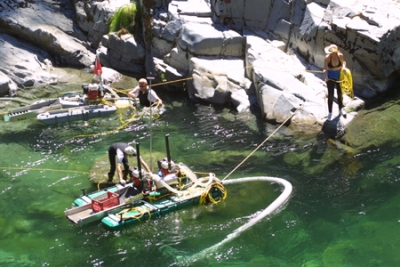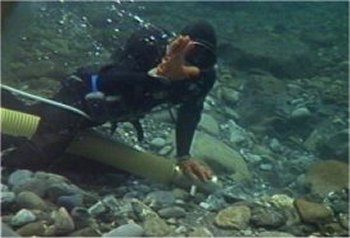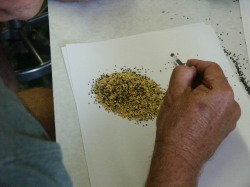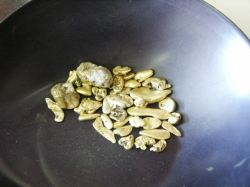By Dave McCracken
“Covering the Basics of Suction Gold Dredging”



Most gold mining today is done in small operations — one or two persons working at a time — often with the use of suction dredges. A suction dredge is a powerful underwater-type of vacuum cleaner. It sucks up streambed material (rocks, sand, gravel, silt, gold and other minerals), passes it up through a suction hose, and runs it across a recovery system floating at the surface. Pieces of gold, which are very heavy, are separated from the other streambed materials and trapped, as the gravel and other material wash through the recovery system and are then washed back into the stream to fill in the hole as the dredge moves forward in the waterway.
 Most intermediate and larger-sized gold dredges come with built-in hookah-air systems. These attach to the same engine that powers the water pump. As demonstrated in the following video segment, air for breathing underwater is generated by an air compressor, passes down through an air line, and provides air to a diver through a regulator, similar to what is used by SCUBA divers:
Most intermediate and larger-sized gold dredges come with built-in hookah-air systems. These attach to the same engine that powers the water pump. As demonstrated in the following video segment, air for breathing underwater is generated by an air compressor, passes down through an air line, and provides air to a diver through a regulator, similar to what is used by SCUBA divers:
Dredging is usually done in ten feet of water or less, but some work is done at greater depths. The following video segment demonstrates how modern suction dredges are constructed with the use of venturi jet systems. These allow gravel and streambed material to be directed into a gold recovery system without having to pass through the pump:
Using a dredge, an (experienced) operator is able to process a much larger volume of streambed material than with any other small-scale hand-mining apparatus. Most of the gold-bearing river-bottom streambed material is sucked up as quickly as the operator is able to feed it into the suction nozzle. Rocks that are too large to pass through the suction nozzle are moved out of the way by hand.
 The early miners who came to California (and elsewhere) during the 1849 gold rush (and later) did find and recover many of the easy-to-find gold nuggets and rich deposits. During those early days, the deposits had to be easy to find and recover; because recovery methods and processing capabilities were very limited. Suction dredge technology allows modern-day gold and gemstone miners to prospect and mine for mineral deposits in places where earlier miners were not able to go. This is true in the deeper rivers (3-meters or more of water depth) all over the world. It is especially true in remote locations and/or within developing countries where modern technology is generally not available to village-miners.
The early miners who came to California (and elsewhere) during the 1849 gold rush (and later) did find and recover many of the easy-to-find gold nuggets and rich deposits. During those early days, the deposits had to be easy to find and recover; because recovery methods and processing capabilities were very limited. Suction dredge technology allows modern-day gold and gemstone miners to prospect and mine for mineral deposits in places where earlier miners were not able to go. This is true in the deeper rivers (3-meters or more of water depth) all over the world. It is especially true in remote locations and/or within developing countries where modern technology is generally not available to village-miners.
Because a modern (experienced) dredger is able to process substantially more volume of streambed material with better gold recovery, the gravel deposits of today do not need to be as rich in gold as was necessary during the past.
One of the main advantages of having the capability to process more streambed material is that an area can be more-effectively sampled. Therefore, the success-rate in modern underwater mining is much greater than it has ever been using other technologies. This has caused a lot of interest in suction dredging equipment, which has resulted in a competitive market. At present, very good equipment for suction dredgingcan be obtained at relatively low cost. Just to give you some idea, a top-of-the-line five-inch gold dredge and the miscellaneous gear needed to run a small dredging operation can be obtained for less than $6,000.
The size of a gold dredge is determined by the inside-diameter of its suction hose–usually anywhere from two to ten inches. A single person customarily can operate a four, five or perhaps even a six-inch dredge. Two men commonly operate six, eight or ten-inch units. Sometimes, when streambed material is deep, and there is a lot of oversized material (large rocks and boulders) that needs to be moved out of the way, as many as four or five persons can be utilized underwater to operate a production gold dredge.


A single, experienced operator who is sampling with a four-inch dredge can process multiple times more streambed material than could be processed at the surface using conventional pick & shovel methods. A six-inch dredge in experienced hands can process about four times as much material as can be accomplished with a 4-inch dredge — and can also dredge several feet deeper into the streambed material while remaining efficiently-productive. An 8-inch dredge can about double the production over a 6-inch dredge and excavate even deeper into the streambed material. And a 10-inch dredge can double production over an 8-inch dredge and excavate even deeper holes. 
The other side of this equation is that each larger dredge-size about doubles the bulk and weight of the equipment that must be moved around and managed. Because of this, some locations may be too remote to support a larger-sized dredge. The limiting-factor on a suction dredge is not the horsepower or the size of the suction hose. It is the size of the suction nozzle opening. Please trust me on this one: It is all about the size of rock that will go up the suction nozzle. Once again, I invite you to closely watch the underwater video segments on my videos and see what is happening underwater. It is almost all about moving the oversized material out of the way. The size of the nozzle-opening determines what can be sucked up, and what must be otherwise moved out of the way by hand.
 A cutter-head will just get bogged down (and damaged) in a normal hard-packed streambed.
A cutter-head will just get bogged down (and damaged) in a normal hard-packed streambed.
Some dredges are available that are operated from the surface with hydraulic-powered cutter-heads at the nozzle. Cutter-heads are mechanical devices that help feed material evenly into the nozzle. They are most-productive in doing channel-work in harbors or making navigation-channels deeper or wider (where the material mostly consists of sand or silt). Cutter-heads cannot replace the need for divers when mining in hard-packed streambeds which are made up mainly of oversized rocks and boulders which must be broken free with pry bars and moved out of the excavation by hand.
 If you want to do serious excavations with a suction dredge, you must leave the opening of the suction-nozzle as large in diameter as possible, while still reducing it enough to eliminate un-necessary plug-ups inside of the suction hose or power jet.
If you want to do serious excavations with a suction dredge, you must leave the opening of the suction-nozzle as large in diameter as possible, while still reducing it enough to eliminate un-necessary plug-ups inside of the suction hose or power jet.
Streams, rivers and creeks in gold-bearing areas are constantly being replenished with fresh gold. During the last 150 years, natural erosion has caused a substantial amount of new gold to become deposited in today’s waterways. Some rivers and streams that were once thoroughly mined by the old-timers are presently paying gold dredgers in very handsome deposits. Rivers that ran too deep for local miners to gain access to the bottom during the past are also producing rich, virgin gold deposits for suction dredgers. 
Gold found in streambeds is called “placer gold.” Placer gold is most commonly found in flake form, usually about the size of flattened grains of rice and smaller. Some deposits carry a larger amount of such flakes and fine-gold. Other deposits carry substantial amounts of larger pieces and nuggets. Gold nuggets can be worth more than actual weight-value, because of their uniqueness as jewelry or specimens.
Gold is one of the heaviest metals. It has a specific gravity of 19.6, meaning that it weighs 19.6 times more than an equal volume of pure water. It is about six times heavier than the average sand, gravel, rocks and other materials which normally make up a streambed. So it takes a substantially-greater force to move gold, than it does to move the other streambed materials. This principle is used in gold recovery systems. The same principle is also used to predictwhere high-grade gold deposits are most likely to be found in a streambed.


Because of its enormous weight, gold tends to follow a certain path of its own when being washed down a waterway, and it will concentrate in common locations where the water force lets up enough to drop gold. One example is the inside of a bend where a stream makes a turn. Another example is at the lower-end of a section of white water. Gold will form “pay-streaks” in areas such as this–where the water slows down on a large scale during large flood storms.
The nice thing about gold dredging is that you can actually see the gold as it is uncovered when you are looking for it. This means that you should pay close attention when you reach the locations where gold is most likely to be, like in the contact zone between different flood layers and on bedrock. Because they are also heavy, lead and iron objects also commonly follow the very same path inside of the waterway as gold, and they deposit inside the same places.
As demonstrated in the following video sequence, with just a little practice, you can learn to look for these positive signs and can follow them right into the high-grade gold deposits:
Once a rich gold deposit is located, as long as there is time, the best thing to do is continue the sampling process long enough to establish the downstream boundary of the deposit. As demonstrated in the following video segment, if the deposit is developed from the lower-end, cobbles and tailings can be deposited further downstream without worry of dropping them directly on top of the rich deposit where they will just have to be moved again at some later time:
 A gold-dredger has an advantage, in that he or she is able to float equipment where he or she wants it to go, sucking up gravel (sampling) from various strategic areas. This is much easier than having to carry equipment around and set it up in each new area, as is required in conventional mining.
A gold-dredger has an advantage, in that he or she is able to float equipment where he or she wants it to go, sucking up gravel (sampling) from various strategic areas. This is much easier than having to carry equipment around and set it up in each new area, as is required in conventional mining.
Most gold dredgers use just two types of knots to secure their dredges in the waterway: (1) several half-hitches, or: (2) a bowline knot. The bowline knot is used where a non-slipping loop is needed at the end of a line. Here follows a demonstration of how to tie a bowline:
There is some amount of gold to be found just about anywhere in a gold-bearing waterway. The important key is to find it in paying quantities. Most commonly, experienced dredgers locate rich pay-streaks by systematically sampling various locations where it seems that gold should have been deposited. Sometimes it takes numerous sample holes to locate a pay-streak, and sometimes it only takes a few. This often depends upon an individual’s understanding of where gold gets hung up in a stream, and upon his or her familiarity with the area that is being sampled.
To accomplish the most from your effort, usually the best way to dredge a sample hole is to move it forward and downward at the same time. This way, you can move steadily away from your growing pile of cobbles (rocks that must be moved out of the hole by hand). Since you usually do not know which way the positive signswill lead you when you begin a sample hole, if possible, it is best to toss your cobbles downstream from the excavation, rather than off to either side or to the front. The idea is to move the same cobbles as few times as possible. The following video segments demonstrate how to obtain optimum production for your effort:
 In fact, most of the work associated with suction dredging involves the organization and movement of cobbles and (sometimes) boulders.How well a person can organize and move the oversized material out of the way will determine how deep and fast the samples can be dredged efficiently. Consequently, this will also determine how quickly your sampling activity will lead you into high-grade pay-streaks. The following video segment further demonstrates this very important principle:
In fact, most of the work associated with suction dredging involves the organization and movement of cobbles and (sometimes) boulders.How well a person can organize and move the oversized material out of the way will determine how deep and fast the samples can be dredged efficiently. Consequently, this will also determine how quickly your sampling activity will lead you into high-grade pay-streaks. The following video segment further demonstrates this very important principle:
For the most part, you want to avoid dredging sample holes straight down into the streambed material. This is because dredging straight down will soon have you off balance. It is much more difficult to remove cobbles from the excavation when you are upside down in the hole. As demonstrated in the following video sequence, if you cannot toss the cobbles far enough out of the excavation, they will just keep rolling back in on you.
Depending upon how deep into the streambed your sample goes, it can sometimes be difficult to get cobbles far enough out of your sample hole on a single toss. In this case, as shown in the following video segment, it can be sometimes be more efficient to relay them out with 2 tosses, rather than try and carry each rock all the way out of the hole. Each situation is different and requires independent judgment on the part of the dredge operator(s).
Dredging can be an exciting and remunerative activity if you are willing to work hard at it. It takes a bit of study and persistence in the beginning–just like any other activity. Anyone contemplating suction dredging as a commercial activity should be aware that there is a learning curve involved, and they should plan on it.
- Here is where you can buy a sample of natural gold.
- Here is where you can buy Gold Prospecting Equipment & Supplies.
- Books & Videos by this Author
- More about gold dredging
- More about how to prospect for gold
- Schedule of Events
- Gold Dredge for Sale






